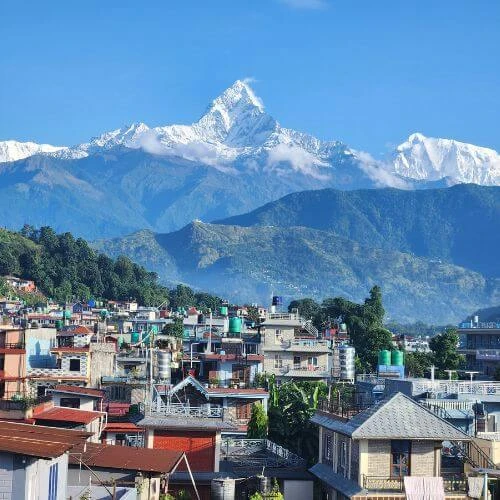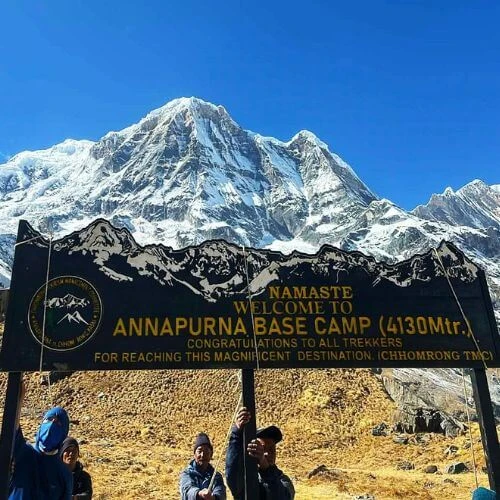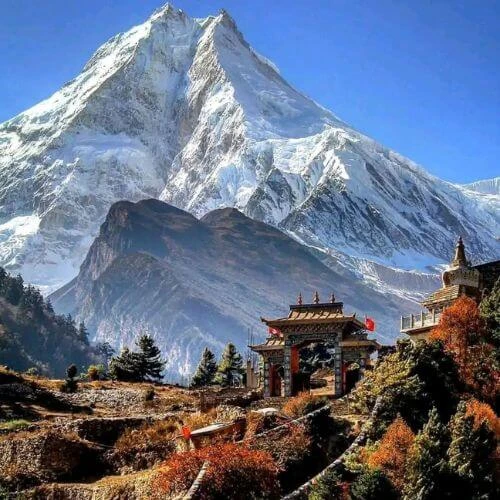Popular Trekking Routes in Nepal during Monsoon Season
Upper Mustang Trek
The Upper Mustang trek offers an incredible adventure through a remote region in the Annapurna Conservation Area of Nepal. Known as a rain-shadow area, Upper Mustang receives much less rainfall than other parts of Nepal during the monsoon season. Until 1950, the Mustang district was an independent kingdom within Nepal's borders and has only been accessible to outside visitors for about 32 years.
The trek through Upper Mustang typically takes 10-15 days, depending on the chosen route. The highest point reached on the trek is the village of Lo Manthang, situated at an elevation of 3,840 meters (12,598 feet). Lo Manthang also called the 'Forbidden Kingdom,' is renowned for its well-preserved ancient architecture and cultural practices that reflect a long and fascinating history. In Lo Manthang, you can explore the remains of the old King's palace and several ancient caves. This village is also home to several very old Buddhist monasteries, including Thubchen Monastery, one of the oldest in the Mustang region. These monasteries are architectural marvels and important centers for Tibetan Buddhist culture and learning.

The landscape of Upper Mustang features a very dry, rocky terrain with flat lands, along with big cliffs and canyons that rivers and glaciers carved long ago. You can spot old cave houses built into the cliffs where people once lived. Despite the arid conditions, green valleys with small villages and fields where crops grow dot the landscape. Ancient monasteries and mud-brick forts blend seamlessly into the natural surroundings. In the distance, the tall snow-capped peaks of mountains like Annapurna and Dhaulagiri tower over the unique environment
Trekking during the monsoon season in the Upper Mustang has its advantages. The region does not face rain-related challenges, and the weather remains clear, providing fascinating views throughout the trek.
Upper Dolpo Trek
The Upper Dolpo trek, which typically takes 16-18 days to complete, is one of the best treks in Nepal to be undertaken during the monsoon season. Upper Dolpo, located in the upper part of the Dolpo region, is another rain-shadow area that receives less rainfall, making it possible to trek during the monsoon season. This remote and rarely visited area opened to visitors only at the end of the 1980s and is still considered a restricted area, requiring a special permit.
The trek offers several attractions. One of the major highlights is Shey Phoksundo Lake, one of the deepest and most popular lakes in Nepal, known for its fresh turquoise water during the monsoon. The trek also takes you through Phoksundo National Park, where you can witness scenic beauty and opportunities for wildlife viewing. Additionally, you can visit Shey Gompa, a significant Buddhist monastery in the region.

Along the trek route, you will pass through various villages and settlements, including Juphal, Kageni, Dunai, Chhepka, Saldang, Rinje, Dho, and Lingdo, offering a glimpse into the local culture and way of life.
While local flights can be delayed due to heavy rainfall, this remote and less-traveled region offers trekkers a unique experience, with stunning natural landscapes, cultural richness, and the opportunity to explore a restricted area of Nepal during the monsoon season.
Nar Phu Valley trek
The Nar Phu Valley is another rain shadow area in Nepal's Annapurna region. This off-the-beaten-path offers a unique opportunity to experience the authentic and unique culture of Nepal through the Narphu people, a Tibetan-Buddhist community that has remained largely untouched by modern influences.
The Nar Phu Valley is situated in the eastern part of the Manang district and was only recently opened to tourists in 2003 AD. During the monsoon season, the valley blooms with lush greenery, adding to the scenic beauty of the trek. It offers breathtaking views of several renowned mountains, including Annapurna II (7,937 m/26,192 ft), Gangapurna (7,455 m/23,379 ft), Himlung Himal (7,126 m/23,379 ft), Chulu Peaks, and the eighth highest mountain in the world, Mt. Manaslu (8,163 m).

The Narphu Valley Trek typically lasts 11-12 days and involves crossing high mountain passes in the Annapurna region, such as the Kang La Pass (5,306 m) and the Thorong La Pass (5,416 m. The Kang La Pass (5,200m) and Thorong La Pass (5,416m) are the highest points of the trek.
To begin the trek, trekkers first need to reach the town of Besisahar, where they can obtain the necessary permits. From there, the trail heads into the Marshyangdi River valley before heading off onto a less-traveled path that leads into the remote and beautiful Narphu Valley trek in Nepal.
The Ghorepani Trek is one of the most popular short treks in Nepal, located in the Annapurna region. It is a 5-6 day short trek starting from Pokhara, with a maximum altitude of 3,210 meters at Poon Hill, which does not require acclimatization throughout the entire trek.
Throughout the trek, you can witness some of the 8,000-meter mountains, including Dhaulagiri (8,167m), Manaslu (8,163m), and Annapurna I (8,091m), as well as other popular peaks like Annapurna South, Machhapuchhre, Nilgiri, Hiunchuli, Tukuche Peak, Dhampus Peak, Gangapurna, and the Annapurna ranges.
The region generally experiences afternoon rain, so it is recommended to hike in the morning for clear mountain views. During the rainy season, the trail is adorned with red rhododendrons and greenery. However, trekking during the monsoon can be slightly more challenging due to slippery trails, leeches, and occasional obstructed mountain views.

It is advisable to have proper gear and guidance when undertaking the Ghorepani Trek during the monsoon season. Regardless of the season, the trek offers stunning mountain views and an opportunity to experience the natural beauty of the Annapurna region.
The Everest Base Camp (EBC) trek stands as one of the most popular and challenging hiking trails in Nepal, renowned for its demanding terrain and breathtaking scenery. Despite the misconception that it cannot be done during the monsoon season, with proper guidance and gear, the EBC trek is doable in every season. Trekking during the monsoon adds an extra challenge, but it also offers the opportunity to enjoy the great views and lush greenery of the Everest region.
Kala Patthar is where the trek reaches its highest altitude of 5,545 meters. While rainfall may occur in the lower regions, conditions tend to improve at higher altitudes. One advantage of trekking during the monsoon season is that it's considered the off-season, resulting in peaceful paths and the possibility of having entire teahouses to yourself. This solitude provides a unique and rewarding experience. Additionally, costs are generally lower during this time, making it an attractive option for budget-conscious trekkers.
The major highlight of the EBC trek is Everest Base Camp itself, standing at an altitude of 5,364 meters. This base camp serves as the camping site for Everest expeditions and offers breathtaking views of Mount Everest, Mount Lhotse, Nuptse, Cho Oyu, Ama Dablam, and other mighty peaks. Trekkers can also witness the awe-inspiring Khumbu Glacier and other icefalls, which are beyond imagination.
Typically, the EBC trek takes 12 to 14 days to complete, starting from Lukla Airport. Since the skies are often clear in the morning, it is advisable to hike early in the day. With proper preparation, determination, and an experienced guide, trekking to Everest Base Camp during the monsoon season can become an unforgettable and rewarding experience.

Rara Lake Trek
Rara Lake, also known as Mahendra Daha, is Nepal's largest and deepest freshwater lake, spanning 10.4 square kilometers. It sits in the Jumla and Mugu districts of Karnali Province, within Rara National Park. The region's relatively short monsoon season makes it an ideal time for trekking in Nepal to visit Rara Lake.
At an elevation of 2,999 meters, the shores of Rara Lake come alive with colorful flowers blooming during the rainy season. The area around the lake, including Mili Chaur, transforms into a vibrant carpet of multi-colored blossoms during the monsoon.
Rara Lake during monsoon season presents a stunning sight, with its crystal-clear turquoise waters surrounded by tall, snow-capped mountains and lush green hills. During the rainy season, the forests around Rara Lake turn a deep green color. Thin clouds slowly move down the mountain slopes. This makes the area look majestic and adds to the appeal of this popular lake in Nepal.

Trekkers can reach Rara Lake from Kathmandu in about 14-15 days, experiencing the region's natural beauty and stunning landscapes along the way.
The Mardi Himal Trek, a trail that recently opened in 2012, offers a unique trekking experience during the monsoon season. Beginning in Pokhara at an elevation of 820 meters and ending at Mardi Himal Base Camp situated at an altitude of 4,500 meters, this trek has been explored by very few people, making it an excellent choice for those seeking a peaceful and uncrowded adventure.
While the lower elevations may experience rain, the peaks of the mountains could be blanketed in snow, providing stunning vistas. The trails may be muddy and slippery, but the lush greenery and blooming rhododendrons make the journey truly captivating. However, one must be cautious about the presence of leeches in this region.

During the trek, you can witness breathtaking views of some of the most iconic Himalayan peaks, including Annapurna South, Hiunchuli, Machhapuchhre (Fishtail), Mardi Himal, Dhaulagiri, Nilgiri, Himchuli, Gangapurna, and Manaslu. The monsoon season offers a unique perspective on this trail, with the added benefit of fewer crowds and a tranquil atmosphere.
Undertaking the Mardi Himal Trek during the monsoon season offers a unique perspective and a chance to experience the trail in a different light.
Langtang Valley Trek
The Langtang Valley Trek, located in Nepal's Langtang region, offers a unique experience even during the monsoon season. While often considered less ideal for trekking, this period transforms the valley into a lush paradise of green meadows, dense forests, and cascading waterfalls. However, it's essential to prepare for slippery trails, leeches, and potential landslides, making proper precautions crucial.
This rewarding journey typically takes 5-7 days, beginning in Syabrubesi and following the Langtang River through picturesque villages. Settlements like Lama Hotel (2,380 meters) and Langtang Village (3,430 meters) are notable stops before reaching Kyanjin Gompa. Many then go for a side trip to Kyanjin Ri (4,773 meters), the trek's highest point, offering breathtaking views of glaciers and surrounding mountains.
The trek showcases impressive Himalayan peaks, including Langtang Lirung and Langtang II (7,227 meters), and Ganesh Himal (7,422 meters). Gang Chhenpo, Dorje Lakpa, Naya Kanga, Kimsung, and Yansa Tsenji are notable mountains. Tserko Ri (5,033 meters) and Laure Binayak Pass (4,609 meters) provide additional trekking opportunities for the adventurous.
Langtang's natural beauty is matched by its rich cultural heritage. Home to Tamang and Sherpa communities, the area's culture is deeply influenced by Tibetan Buddhism. Prayer flags, mani walls with Buddhist inscriptions, and chortens (Buddhist shrines) add visual appeal and offer insights into the beliefs and traditions that have shaped life in these mountains for generations.

Dhorpatan Trek
The Dhorpatan Trek is one of Nepal's lesser-known, off-the-beaten-path destinations. It primarily lies within the Dhorpatan Hunting Reserve, the only hunting reserve in Nepal, spanning the districts of Rukum, Myagdi, and Baglung in the Dhaulagiri Himal range in West Nepal. As it is a hunting reserve, authorities strictly regulate permits, and they allow hunting only during specific seasons.
Trekking during the monsoon in this region offers a unique experience. Dhorpatan in monsoon comes alive with beautiful meadows, forests, and hills, all flourishing with fresh foliage and blooming flowers. The monsoon season brings cooler temperatures, making the trek more comfortable compared to the scorching summer heat. Many animals and birds become more active during the monsoon, increasing the chances of spotting wildlife and hearing the melodious calls of various bird species.
This trek typically takes about 11-12 days. It usually starts from Beni, the headquarters of Myagdi district, located at an altitude of about 830 meters (2,723 feet). You can reach Beni by bus from Pokhara, one of Nepal's major cities. Alternatively, some trekkers begin their journey from Darbang, a village further along the route that is accessible by jeep from Beni. The traditional endpoint of the trek is the town of Dhorpatan, situated at an elevation of approximately 2,850 meters (9,350 feet) within the Dhorpatan Hunting Reserve.

While authorities strictly regulate hunting, the reserve hosts diverse wildlife, including blue sheep, Himalayan tahr, leopards, and various bird species. The trail offers spectacular views of the Dhaulagiri massif, including Dhaulagiri I, the world's seventh-highest peak at 8,167 meters (26,795 feet). Due to limited teahouse infrastructure, many parts of this trek require camping. For some trekkers, pitching tents in beautiful, remote locations is a highlight in itself.
Badimalika trek
The Badimalika Trek during monsoon offers a special adventure in far western Nepal, starting from Martadi town and ending in Kolti, spanning approximately 10 to 12 days. This popular Nepal trek in monsoon showcases the area in a new light, with lush greenery brought alive by the rain.
The highlight is the Badimalika Temple, situated at an elevated 4,200 meters in the mountains. Trekkers must cross over vibrant forests, picturesque meadows, and high mountain passes to reach this temple.
Along the journey, trekkers will come across villages inhabited by diverse groups like Thakuris, Chhetris, and Brahmins, providing insights into their unique traditions and ways of life. Some routes may also pass through Khaptad National Park, renowned for its rich biodiversity.

On clear days, breathtaking views of prominent peaks like Api, Saipal, and Phoksundo from the Api-Saipal Himalayan Range can be seen, standing majestically against the backdrop of rain clouds.
This trek appeals to adventurers seeking to explore lesser-visited parts of Nepal during the enchanting monsoon season. It offers opportunities to immerse oneself in nature's beauty, discover varied cultures, and embrace the serene ambiance of the mountains.
Conclusion
While the monsoon season in Nepal brings heavy rainfall and lush greenery to the country, it also opens up opportunities for some incredible trekking experiences. Trails like the Upper Mustang Trek, Ghorepani Poon Hill Trek, and Langtang Valley Trek offer stunning views of vibrant landscapes, cascading waterfalls, and vibrant wildflowers in bloom. With fewer crowds and cooler temperatures, these monsoon treks provide a unique and serene way to immerse yourself in the natural beauty of the Himalayas. Hotels in Nepal offer excellent accommodation options for trekkers during the monsoon season, catering to their needs and ensuring a comfortable stay before and after their treks. Whether you're an experienced trekker or a nature enthusiast, Nepal's monsoon treks are a memorable adventure that shouldn't be missed.
Frequently asked questions
What are the accommodation options during the monsoon season?
Most trekking routes have teahouses and lodges that remain open during the monsoon season. However, facilities might be basic, and checking availability in advance is advisable.
Is it safe to trek in Nepal during the monsoon season?
It is generally safe to trek in Nepal during the monsoon season, but it comes with challenges such as heavy rainfall, landslides, and slippery trails. Proper preparation and choosing the right trails are essential.
When is the monsoon season in Nepal?
The monsoon season in Nepal typically lasts from June to early September.

What should I pack for a monsoon trek in Nepal?
Packing essentials include:
- Waterproof clothing and gear (rain jacket, waterproof backpack cover)
- Quick-drying clothes
- Good quality trekking boots with proper grip
- Mosquito repellent
- Trekking poles for stability on slippery trails
- Waterproof bags for electronics and important documents
How are the trail conditions during the monsoon in Nepal?
Trail conditions can be challenging due to mud, landslides, and slippery paths. It's important to be prepared for delays and difficult terrain



 based on 5 reviews
based on 5 reviews
















